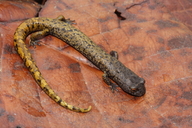|
Pseudoeurycea granitum
English name: Granite-colored salamander; Spanish name: Salamandra de color granito | family: Plethodontidae subfamily: Hemidactyliinae genus: Pseudoeurycea |
| Species Description: García-Bañuelos P, JL Aguilar-López, A Kelly-Hernández, V Vásquez-Cruz, E Pineda, and SM Rovito. 2020. A new species of Pseudoeurycea (Amphibia: Caudata) from the mountains of central Veracruz, Mexico. Journal of Herpetology 54: 258-267. | |
 © 2021 Sean Michael Rovito (1 of 5) |
|
|
|
Description According to analysis of mtDNA, the groups most closely related to P. granitum include P. firscheini, P. leprosa, P. lynchi, and P. nigromaculata. However, these species have detectable differences in their color patterns and morphology, specifically regarding the interorbital bar. Pseudoeurycea firscheini, the species most closely related to P. granitum, is gray-brown in color and has a shorter tail and narrower head. Pseudoeurycea firscheini also lacks the black spots and yellowish coloring that is seen in P. granitum. Pseudoeurycea leprosa is a dark grayish-brown, is notably larger than P. granitum, and has no yellow coloring anywhere on its body. Pseudoeurycea lynchi is greenish-yellow with black spots over its entire body and tail, while P. granitum only has this yellow coloring on its tail and posterior dorsum with paler blotches or specks. Similarly, P. nigromaculata has a reddish-brown tail, making its coloring distinct from both of the previously mentioned species. Pseudoeurycea granitum specimens are smaller than both P. nigromaculata and P. lynchi, regardless of sex. Lastly, Pseudoeurycea granitum has a white or brown interorbital bar that extends between its eyelids; this feature is absent in any of the other aforementioned Pseudoeurycea species (García-Bañuelos et al. 2020). In life, Pseudoeurycea granitum is brown with small black and white speckles from its head to its forelimbs. There is a brown or white interorbital bar that extends between the two eyelids. The dorsal surface between the shoulders and the base of the tail is yellowish-green with yellow speckles and black blotches. The dorsal surface of the tail, as well as the dorsal surface of all limbs, is also yellowish-green and has black spots. The sides of P. granitum are black with lichen-like light green blotches. On the gular surface, it is light gray, and the ventral surface of this species is black with light green and white speckles. The underside of hands and feet are light gray and the eyes are golden. In preservation, P. granitum is various shades of gray. The dorsal surface is medium gray with light spots, and the tail has dark gray splotches. The interorbital bar is a medium gray. The flanks and the ventral surface are dark gray with a variety of lighter spotting or mottling. The ventral side of the tail is medium gray, but it becomes more yellow toward the end (García-Bañuelos et al. 2020). The variation between male and female Pseudoeurycea granitum individuals is most visible in certain physical characteristics. Males have well-developed, blunt nasolabial grooves and visible mental glands; females have poorly-developed nasolabial grooves and no mental glands, as mental glands are a secondary sex characteristic exclusive to males. The amount of spotting on the ventral surface and chin varies between each P. granitum individual. Additionally, the size and color of the interorbital bar varies by individual. The colors of the interorbital bar can range from white to yellowish-green, and it can be as wide as the eyelid or so thin that it cannot be easily seen (García-Bañuelos et al. 2020). Distribution and Habitat Country distribution from AmphibiaWeb's database: Mexico
Life History, Abundance, Activity, and Special Behaviors Pseudoeurycea granitum females likely lay eggs during the first months of the year -- much like their close relatives -- but this has not been shown for certain. Further surveys must be conducted to verify their reproductive patterns (García-Bañuelos et al. 2020). Pseudoeurycea granitum is sympatric with P. firscheini in Cerro Petlalcala. More surveys must be conducted to determine if it overlaps in range with other Pseudoeurycea species (García-Bañuelos et al. 2020). Despite extensive searches around the state of Veracruz, there have been very few Pseudoeurycea granitum individuals found. Because of their limited sightings and observations, this species is likely rare. To confirm this, more surveys are needed at different points during the year (García-Bañuelos et al. 2020). While there is no explicit mention of what Pseudoeurycea granitum salamanders eat, they are prey animals to snakes. This is evidenced by one of the collected specimens that was regurgitated by a Thamnophis sumichrasti (García-Bañuelos et al. 2020). Trends and Threats Possible reasons for amphibian decline General habitat alteration and loss Comments Pseudoeurycea granitum is a member of the Pseudoeurycea leprosa subclade. To determine the genetic relationship between P. granitum and other Pseudoeurycea species, researchers analyzed 16S mtDNA with a fragment of cytochrome b using Maximum Likelihood Method and a Bayesian phylogenetic analysis. From this, they found that P. granitum is sister to the clade containing P. firscheini and P. nigromaculata. The clade form by these three species are sister to P. lynchi and the next most closely related species is P. leprosa (García-Bañuelos et al. 2020). The species name, “granitum”, is the Latin word for “granite.” Pseudoeurycea granitum resembles granite because of its multicolored speckles and splotches (García-Bañuelos et al. 2020). When conducting field surveys, one salamander specimen was found when its body was regurgitated by a snake (Thamnophis sumichrasti) (García-Bañuelos et al. 2020).
References
García-Bañuelos, P., Aguilar-López, J.L., Kelly-Hernández, A., Vásquez-Cruz, V., Pineda, E., and Rovito, S.M. (2020). ''A New Species of Pseudoeurycea (Amphibia: Caudata) from the Mountains of Central Veracruz, Mexico.'' Journal of Herpetology, 54(2), 258-267. [link] Originally submitted by: Ash Reining (first posted 2020-10-30) Edited by: Ann T. Chang (2020-10-30) Species Account Citation: AmphibiaWeb 2020 Pseudoeurycea granitum: English name: Granite-colored salamander; Spanish name: Salamandra de color granito <https://amphibiaweb.org/species/9236> University of California, Berkeley, CA, USA. Accessed Apr 26, 2024.
Feedback or comments about this page.
Citation: AmphibiaWeb. 2024. <https://amphibiaweb.org> University of California, Berkeley, CA, USA. Accessed 26 Apr 2024. AmphibiaWeb's policy on data use. |


 Map of Life
Map of Life